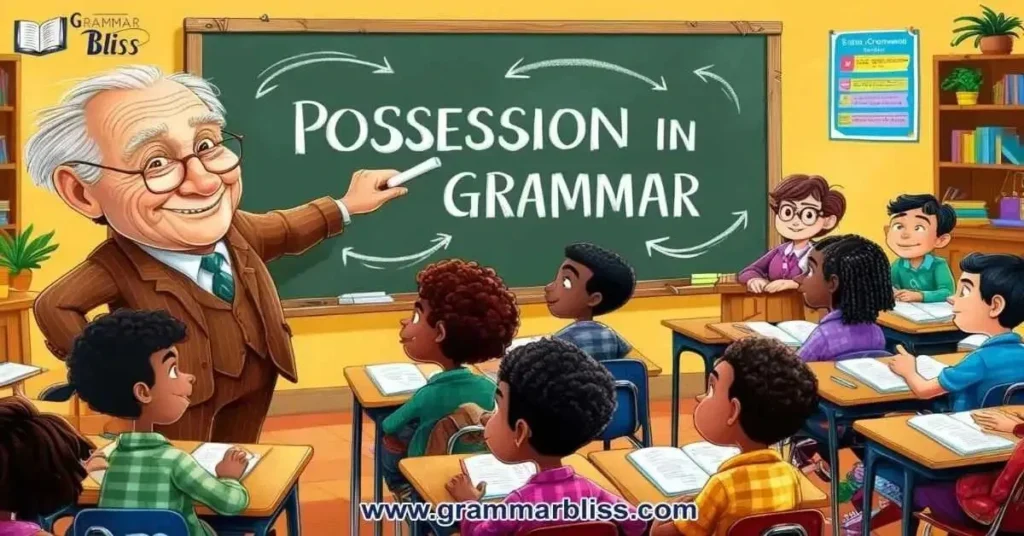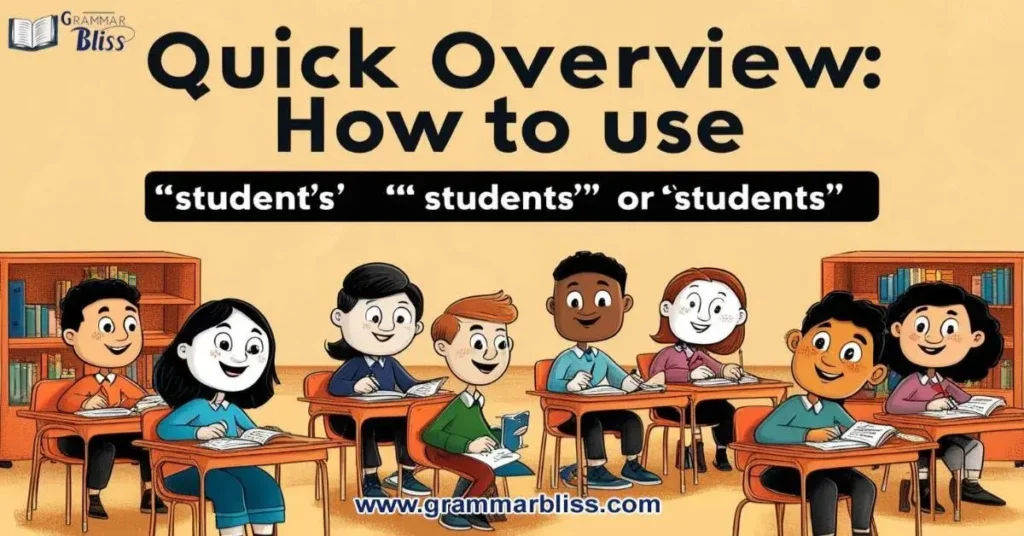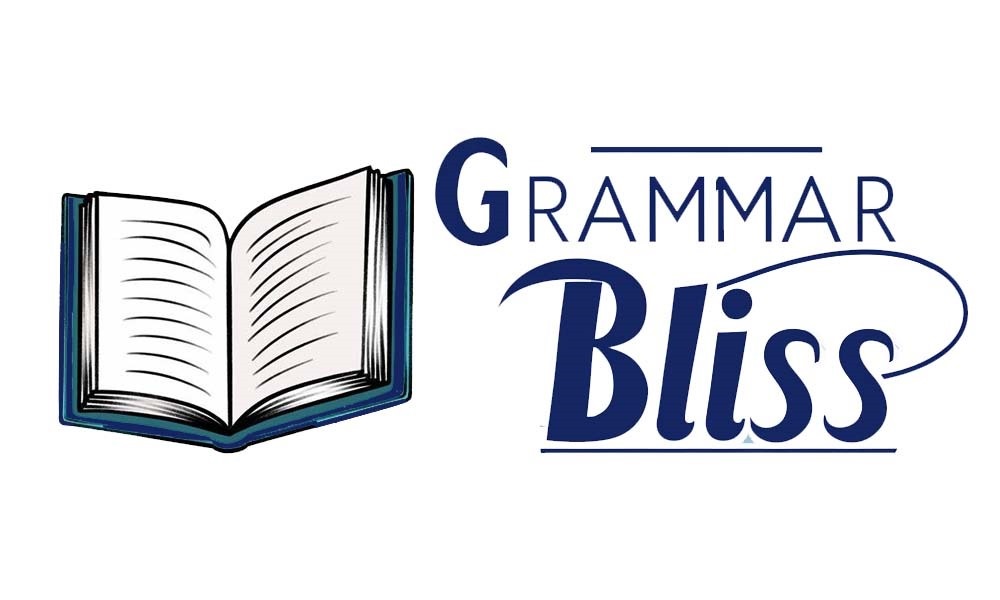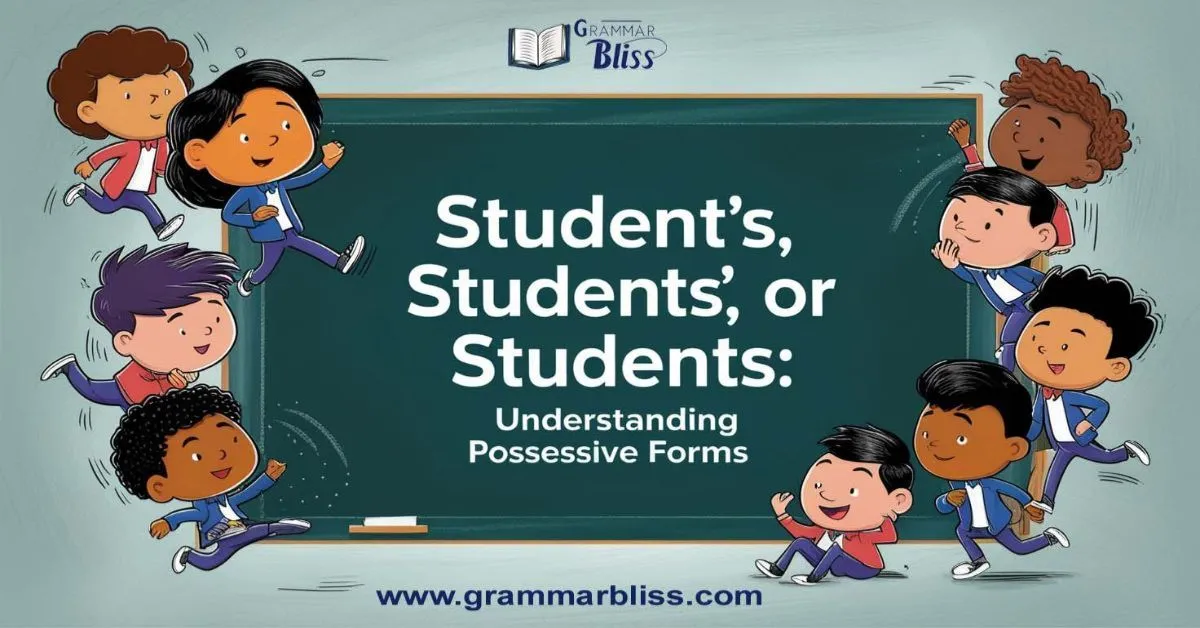Understanding the difference between “Student’s,” “Students’,” or “Students” is essential for clarity in both writing and grammar. These forms show possession and are vital in ensuring proper sentence structure and grammar correction. Using them incorrectly can confuse the meaning of your sentences, leading to misunderstanding.
Whether you’re teaching grammar, learning it, or refining your writing style, it’s important to know when to use each form.
This article will help you understand the correct use of “Student’s,” “Students’,” or “Students” with clear examples and explanations, improving your sentence formation and overall language clarit.y
Quick Summary
At first glance, “Student’s,” “Students’,” or “Students” might seem almost the same, but they’re not. They serve different purposes depending on whether you’re talking about ownership or simply referring to more than one student. “Student’s” refers to something belonging to one student, while “Students’” indicates possession by more than one student.
“Students” is just the plural form, used when referring to multiple students without showing possession. Mastering these forms will ensure your grammar is spot on, avoiding common grammar mistakes that can confuse readers.
See More: Emersion Vs Immersion
What is Possession in Grammar?

In grammar, possession shows ownership or the relationship between things. It helps clarify who owns or is associated with something.
For Example, when we say, “The student’s book,” the word “student’s” shows that the book belongs to one student. In simple terms, possession tells us who owns an item, whether it’s a book, a pencil, or a backpack.
There are three main forms we use in English to show possession: the singular possessive, the plural possessive, and the plural form. Understanding how to use these forms correctly is essential for clarity in writing. Without them, a sentence can be confusing or unclear.
For Example, if we say, “The students books are on the desk,” it would be hard to know if we’re talking about one student’s books or many students’ books. Using the correct possessive form helps make the sentence clear and easy to understand.
Singular Possessive: Student’s
The singular possessive form is used when talking about something that belongs to one person. When we want to show that one student owns something, we add ’s to the end of the singular noun, in this case, “student.” So, “student’s” means that something belongs to a single student.
For Example, you might say, “The student’s notebook is on the table.” Here, “student’s” tells us that the notebook belongs to one student. This is a simple way to show ownership in English grammar.
By following the rule of adding ’s, we make it clear whose notebook we are talking about.
Examples of Singular Possessive
Let’s look at some more examples of singular possessive in action. When you use “student’s” correctly, your writing becomes clearer, and the meaning is easy to follow.
- “The student’s pencil was sharp.”
- “The student’s backpack was on the chair.”
- “The student’s project was impressive.”
In each of these examples, “student’s” shows that something belongs to one student. Whether it’s a pencil, backpack, or project, the possession is clear and easy to understand.
Plural Possessive: Students’
When we’re talking about something that belongs to more than one student, we use the plural possessive form. This form is a little different from the singular possessive.
First, we change “student” into its plural form “students”, and then we add ’ at the end of the word to show possession.
For Example, you might say, “The students’ notebooks are on the desk.” Here, “students’” tells us that the notebooks belong to more than one student. The possessive apostrophe comes after the plural noun, which is “students” in this case.
See More: Campus’ or Campus’s
Examples of Plural Possessive
Few examples of the plural possessive form to see how it works in different sentences:
- “The students’ books were on the shelf.”
- “The students’ shoes were neatly arranged.”
- “The students’ opinions were valuable during the discussion.”
In these examples, “students’” shows that something belongs to multiple students. By adding the apostrophe after the plural noun, we clearly communicate that the item or idea belongs to more than one person.
Plural Form: Students
It’s also important to know when to use the plural form of a noun without showing possession. When we’re simply talking about multiple students, and we’re not indicating ownership, we use “students” as the plural noun. We don’t add an apostrophe here.
For Example, you might say, “The students are working on their projects.” Here, we are talking about a group of students, but there’s no possession involved. It’s just a plural noun.
Examples of Plural
Let’s look at some examples where we use the plural form without possession:
- “There are many students in the classroom.”
- “The students are sitting quietly in their seats.”
- “The students raised their hands to ask questions.”
In these sentences, “students” simply refers to more than one student, but there’s no indication that anything belongs to them. The plural form is used to show that we are talking about a group of people.
Quick Overview: How to Use “Student’s,” “Students’,” or “Students”

It can be tricky to know when to use “student’s,” “students’,” or “students” in your writing, but here’s a quick overview to help you:
- “Student’s” is used when talking about something that belongs to one student.
- “Students’” is used when something belongs to more than one student.
- “Students” is used when talking about multiple students without showing possession.
Knowing which form to use depends on whether you’re talking about one student, more than one student, or just referring to a group of students without indicating ownership.
Side by Side Comparison
To make things even clearer, here’s a side-by-side comparison of how to use “student’s,” “students’,” or “students” correctly:
| Form | Usage | Example |
|---|---|---|
| Student’s | Possession of one student | “The student’s notebook is on the table.” |
| Students’ | Possession of multiple students | “The students’ uniforms are neatly folded.” |
| Students | Talking about many students without possession | “The students are taking notes in class.” |
| Student’s | Describing something belonging to one student | “The student’s presentation was impressive.” |
| Students’ | Describing something belonging to many students | “The students’ opinions were heard during the meeting.” |
| Students | Referring to a group of students in general | “The students will attend the field trip tomorrow.” |
Synonyms of “Student’s,” “Students’,” or “Students”
While “student’s” and “students’” are the most common possessive forms, there are some synonyms or similar terms you might encounter depending on the context.
For Example, “pupil’s” can sometimes replace “student’s” when talking about school-aged children. “Learners’” or “classmates’” may also be used in certain situations.
However, it’s important to use these alternatives correctly to avoid confusion. “Student’s” and “students’” remain the standard possessive forms for most situations.
See More: Trainning or Training
Why It’s Important to Use These Correctly

Using the correct possessive form is not just about following rules of grammar; it’s also about clarity. When you use the right form, your writing becomes easier to understand, and your message is communicated more clearly. On the other hand, using the wrong form can confuse the reader or make your writing feel awkward.
For Example, saying “The students backpack is on the desk” doesn’t make sense because it mixes the plural form “students” with a singular possessive.
Correct grammar usage helps you avoid mistakes, and it’s crucial when writing in both formal and informal contexts, especially in school or work.
Grammar Rules and Examples
Understanding possessive rules can help you avoid common mistakes. Here are some grammar tips for using “student’s,” “students’,” or “students” correctly:
- Singular possessive: Add ’s to the end of the singular noun (e.g., student’s).
- Plural possessive: Change the noun to its plural form (e.g., students), then add an apostrophe after the s (e.g., students’).
- Plural form: For more than one student, just use the plural noun students without an apostrophe.
FAQ’s: “Student’s,” “Students’,” or “Students”
Is “student’s” only used for singular things?
Yes, “student’s” is used for singular possession.
When do I use an apostrophe with “students”?
Use an apostrophe when indicating possession: “student’s” for one student, and “students'” for multiple students.
Can I use “students'” for both singular and plural?
No, “students'” is used only for plural possession. For singular possession, use “student’s.”
Can I use “Student’s” for a group of students?
No, use “Students’” for a group or multiple students.
Conclusion
Mastering the use of “Student’s,” “Students’,” or “Students” is crucial for clear and accurate grammar in your writing. By understanding the difference between singular possessive and plural possessive forms, you can ensure proper ownership and avoid confusion. Whether you’re talking about one student’s book or multiple students’ backpacks, knowing when to use each form will enhance your language clarity. Remember, practicing these possessive rules will not only improve your writing but also help you communicate more effectively and correctly in everyday situations.

